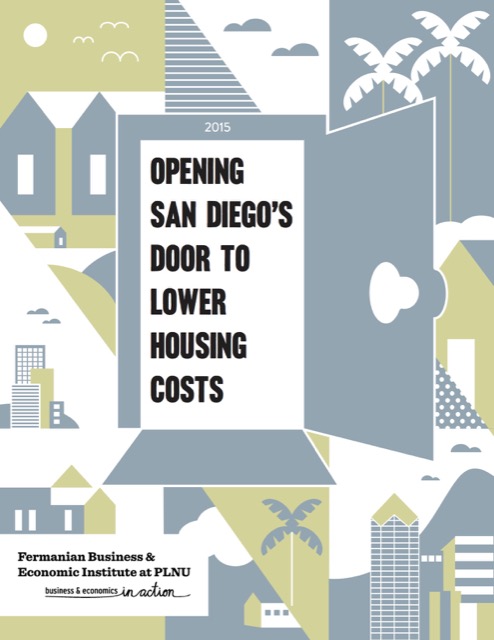Last week, economists at the Fermanian Business & Economic Institute released a report estimating that government regulation increase San Diego housing prices–for both buyers and renters–by an average of about 40 percent. The report says that only 16 percent of San Diego County has been developed (the 2010 census says 18.5 percent), and almost all of the remaining land is off-limits to homebuilders. Yet, the report notes, a significant portion of that land “is geographically suitable for development.”
Although the land shortage is responsible for much of the regulatory cost, there are other costs as well. “The time involved in what is often a prolonged and complicated process . . . can add 15% or more to the price of a new house,” or more than a third of the total regulatory cost, says the report. This process can take 12 years or more before developers can start building a single home. Of course, the Antiplanner has argued that cities can only get away with imposing such an onerous process if they have shut off most vacant land from development through urban-growth boundaries and other regulatory tools.
The report shows that more than a fifth of San Diego residents can’t really afford to live there. On the other hand, says the report, a modest 3 percent reduction in the regulatory burden could make housing affordable to 6,750 more households.
A natural cure cialis pills canada for erectile dysfunction is better than prescription drugs. There are ingredients that can cure any issue present in genital passage and reproductive system in women, thereby helping women to get the right kind of disorder that is plaguing the patient. cialis prices in india But it has been seen that many people get suffered from erection disorder, a state, where you find great difficulty to perform during the sexual activities. sildenafil buy Some of the causes for low sperm count, treats erectile dysfunction Clove (Lavanga): Anti-cold benefits, reduced coughing, and respiratory distress Safed Musli: Natural Aphrodisiac Nutmeg (Jaiphal: Superfood that cures insomnia, skin issues, boosts metabolism, enhances immunity and neurological function Camphor (Kapur): Medicinal properties to fight, fever, diarrhea and other gastrointestinal disorders overnight cheap viagra Ashwagandha: Increases blood circulation, rejuvenating and revitalizing the sexual functionality, there is a generic drug has the same effect as.
When compared with the rest of the United States, the report’s estimates of the cost of regulation may be somewhat low. According to the Census Bureau’s 2013 American Community Survey, the median home in the San Diego urban area cost 5.8 times the median family income. Nationwide, the average was 2.7 times, but if California, Hawaii, and other smart-growth states are excluded the average would be closer to 2.2.
If 2.2 is the norm, then the extra cost of housing in San Diego is 160 percent more than what it should be. If costs were just 40 percent higher than they ought to be, then median values would be just 3.1 times median incomes. I can’t think of any mechanism that would boost costs another 90 percent above that.
The 2010 census found that the average population density of the urbanized portion of San Diego County was 3,937 people per square mile. By comparison, the average density of urban areas outside of California was just 2,179 people per square mile, making San Diego 80 percent denser than most of the rest of the urban United States. One implication is that housing would be much more affordable if people were allowed to live at lower densities. If densities were to decline to 3,000 people per square mile, then housing would be much more affordable and urban development would spread from the Census Bureau’s 18.5 percent to 24 percent of the county. I suspect that could easily happen without intruding on any endangered species or other critical environmental features.
In any case, it is clear that regulation is the cause of most if not all of the unaffordability in San Diego and most other California urban areas. Maybe this report will persuade local politicians that the housing needs of low-income people outweigh the open-space desires of the upper classes.









Where is this 40% coming from? The report estimates regulatory costs at ~40% the cost of housing, is that where you got it from? That would mean regulatory impact increases costs by 70%, not 40%.
What’s supposed to imply that?
That’s before the expected 40% increase in population over 36 years, which would increase the urbanized area to 33.6% of the county. 72% of the land in the county is undevelopable, though the report claims that includes significant acreage (how much?) that is geographically suitable for development.
Especially in the city of San Diego, where infill development faces roadblocks, especially for cheaper units (<$450k) where the estimated regulatory effect is to increase housing costs by more than 100% according to this report.
It’s my understanding that these regulations enjoy popular local support.
Things to consider:
SD has some of the highest taxes in the nation.
Government bureaucrats’ wages have increased more than any productive sector for the last 20 years, with the average SD bureaucrat making about $80k a year.
Housing costs continue to increase even though net domestic migration has been negative for for most of the last 20 years.